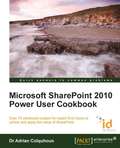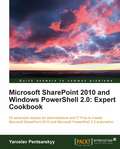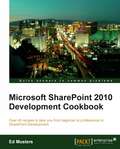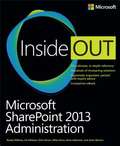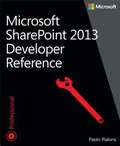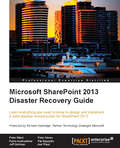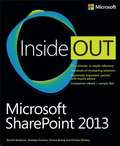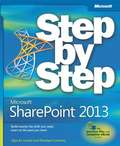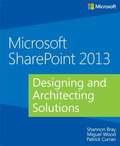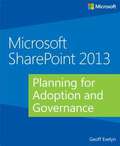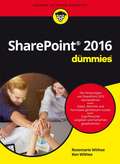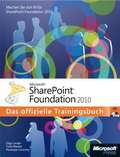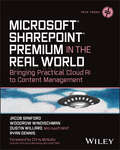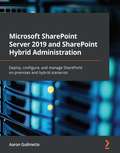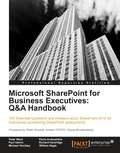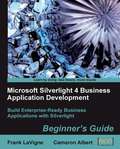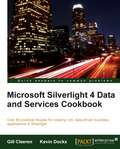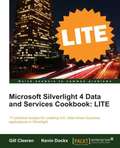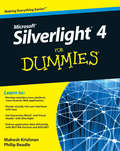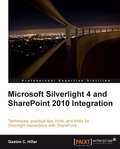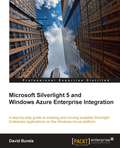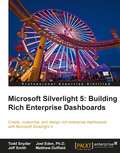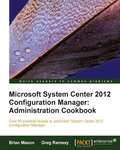- Table View
- List View
Microsoft SharePoint 2010 Power User Cookbook: SharePoint Applied
by Adrian ColquhounThis hands-on cookbook takes readers through many highly applicable intermediate and advanced SharePoint recipes, as well as offering three real-world business scenarios to complement the knowledge already gained. The book specifically sets out to cover important SharePoint 2010 topics that are often avoided by other authors. If you are an advanced End User or Power User of SharePoint 2010 who wants to accomplish specific business tasks beyond the basics, then this cookbook is not to be missed. You should already be comfortable with SharePoint in order to get the most out the recipes, which are applicable up to and including SharePoint Enterprise edition. You'll find this book useful not only as a learning tool, but also as a reference guide as your SharePoint skills and experience increase.
Microsoft SharePoint 2010 and Windows PowerShell 2.0: Expert Cookbook
by Yaroslav PentsarskyyMicrosoft SharePoint 2010 and Windows PowerShell 2.0: Expert Cookbook is a concise and above all advanced cookbook, with practical expert recipes for SharePoint and PowerShell automation. If you are a SharePoint administrator or IT Pro who wants to extend your knowledge of PowerShell automation, this book is a must have. You should have a solid grasp of working with SharePoint and PowerShell respectively.
Microsoft SharePoint 2010 development cookbook
by Ed MustersThe plan of the book is to build a relationship with the Author as your personal guide through the most common "pattern" of SharePoint development. In cookbook style, you will be led carefully step by step through a comprehensive set of recipes. The practical example starts quickly and builds logically throughout the chapters to create a common theme. You will be developing coding techniques that you will be able to apply to the real world. In fact, this book will train you for the first SharePoint development project you will join. This book is written for the ASP.NET developer who wants to get to the goal of "professional" SharePoint 2010 developer as quickly as possible, by learning the most important practical aspects of development that will be used in the real world.
Microsoft SharePoint 2013 Administration Inside Out
by Brian Alderman Milan Gross Chris Givens Ca Callahan Javier Barrera Randy WilliamsConquer Microsoft SharePoint 2013 administration--from the inside out! Dive into SharePoint 2013 administration--and really put your systems expertise to work! This supremely organized reference packs hundreds of timesaving solutions, troubleshooting tips, and workarounds. Discover how the experts deploy, configure, and manage SharePoint--and challenge yourself to new levels of mastery. Automate the installation and configuration of SharePoint 2013 Effectively manage SharePoint apps and custom solutions Optimize farms, web apps, content databases, and site collections Use methods to help users attain productive search experiences Configure business intelligence features in SharePoint 2013 Dive deep into SharePoint security practices and architecture Add SharePoint Online to your existing SharePoint environment Manage User Profiles and the SharePoint social experience Monitor and troubleshoot SharePoint with insider tips For Intermediate to Advanced IT Professionals
Microsoft SharePoint 2013 Developer Reference
by Paolo PialorsiDesign and develop great solutions using SharePoint 2013 Develop your business collaboration solutions quickly and effectively with the rich set of tools, classes, libraries, and controls available in Microsoft SharePoint 2013. With this practical reference, enterprise-development expert Paolo Pialorsi shows you how to extend and customize the SharePoint environment--and helps you sharpen your development skills. Ideal for ASP.NET developers with Microsoft .NET and C# knowledge. Discover how to: Create custom SharePoint apps and publish them in the Office Store Orchestrate your workflows with the new Workflow Manager 1.0 Access and manage your SharePoint data with the REST APIs Federate SharePoint with Windows Azure Access Control Services Customize your SharePoint 2013 UI for a better user experience Gain a thorough understanding of authentication and authorization
Microsoft SharePoint 2013 Disaster Recovery Guide
by Peter Ward Pat Esposito Peter Abreu Joel Plaut Jeff Gellman Pavlo AndrushkiwThe style and approach of the book is an easytoread SharePoint admin guide. This is not a stepbystep instruction book, but rather a guide on how to implement and execute a disaster recovery plan to your SharePoint environment.This book is great for both SharePoint and SQL administrators new to the SharePoint 2013 architecture, and who are looking to get a good grounding in how to use implement a solid disaster recoveryrecovery plan. It's assumed that you have some experience in SharePoint and Windows Server and, as well be familiar with SQL.
Microsoft SharePoint 2013 Inside Out
by Penelope Coventry Thomas Resing Darvish Shadravan Christina WheelerConquer SharePoint 2013--from the inside out! You're beyond the basics, so dive right into SharePoint 2013--and really put your business collaboration platform to work! This supremely organized reference packs hundreds of timesaving solutions, troubleshooting techniques, and workarounds. It's all muscle and no fluff. Discover how the experts facilitate information sharing across the enterprise--and challenge yourself to new levels of mastery. Efficiently manage documents throughout the enterprise Build team sites and collaborate with Microsoft OneNote and SkyDrive Design workflows with SharePoint Designer and Microsoft Visio Produce e-forms using Microsoft InfoPath and Access Manage community sites using business social features Connect SharePoint to external data and business systems Create business intelligence dashboards and key performance indicators Customize and control Sharepoint enterprise search
Microsoft SharePoint 2013 Plain & Simple
by Johnathan Lightfoot Scott Metker Michelle LopezGet the full-color, visual guide that makes learning Microsoft SharePoint 2013 plain and simple! Follow the book's easy steps and screenshots and clear, concise language to learn the simplest ways to get things done. Here's WHAT you'll learn: Create libraries for all kinds of media Share information in one location Organize people and processes Connect SharePoint to Microsoft Office with no fuss Find things fast with the Search Center Expand your community with social networking Here's HOW you'll learn it: Jump in wherever you need answers Follow easy STEPS and SCREENSHOTS to see exactly what to do Get handy TIPS for new techniques and shortcuts Use TRY THIS! exercises to apply what you learn right away
Microsoft SharePoint 2013 Step by Step
by Penelope Coventry Olga M. LonderThe smart way to learn Microsoft SharePoint 2013--one step at a time! Experience learning made easy--and quickly teach yourself how to boost team collaboration with SharePoint 2013. With Step by Step, you set the pace--building and practicing the skills you need, just when you need them! Customize your team site's layout, features, and apps Manage and share ideas, documents, and data Capture and organize content into lists and libraries Automate business processes with built-in workflows Use social features to communicate and collaborate Publish content using enhanced web content management
Microsoft SharePoint 2013: Designing and Architecting Solutions
by Patrick Curran Shannon Bray Miguel WoodGet the information you need to make good SharePoint design decisions Determine the best design for your SharePoint implementation by gaining a deeper understanding of how the platform works. Written by a team of SharePoint experts, this practical guide introduces the Microsoft SharePoint 2013 architecture, and walks you through design considerations for planning and building a custom SharePoint solution. It's ideal for IT professionals, whether or not you have experience with previous versions of SharePoint. Discover how to: Dive deeper into SharePoint 2013 architecture components Gather requirements for a solution that fits your needs Upgrade from Microsoft SharePoint 2010 to 2013 Design service applications for performance and redundancy Provide the right storage plan for a SharePoint farm Map authentication and authorization requirements to your solution Take steps necessary to design a secure implementation Plan your business continuity management strategy Validate your SharePoint architecture to ensure success
Microsoft SharePoint 2013: Planning for Adoption and Governance
by Geoff EvelynDeliver a successful SharePoint solution to your organization Take control of the complex requirements for delivering a SharePoint 2013 solution to your organization. Led by a SharePoint MVP specializing in SharePoint service delivery, you'll learn proven methods to help you prepare for a smooth adoption and governance process throughout the enterprise. This guide is ideal for IT professionals, including service delivery managers, project and program managers, and business analysts. Discover how to: Align your SharePoint solution with organizational goals and business priorities Engage executive sponsors, stakeholders, and SharePoint champions Provide detailed plans and schedules for an effective, structured delivery Build a team with appropriate roles to match delivery requirements Prepare user adoption, training, and communication plans, with clear business rules and policies Plan ongoing platform governance, service releases, and solution maintenance Build effective customer service models and provide SharePoint support
Microsoft SharePoint 2016 für Dummies (Für Dummies)
by Ken Withee Rosemarie WitheeEin Portal, das den Austausch und die Kollaboration enorm fördert, in dem alle wichtigen Informationen verfügbar sind und auf das man jederzeit und überall zugreifen kann - das ist Microsoft SharePoint. Ken Withee beschreibt in diesem Buch die vielen Möglichkeiten, die SharePoint bietet, und zeigt, wie Sie Arbeitsabläufe innerhalb Ihrer Firma optimieren. Ansprechpartner, Dokumente, Grafiken - alles ist übersichtlich und sicher hinterlegt. Projekte werden über Project Server gemeinsam organisiert. Die Version 2016 ist noch enger mit Office 365 verknüpft, der Zugriff auf die Daten ist bequem und einfach möglich.
Microsoft SharePoint Foundation 2010 - Das offizielle Trainingsbuch
by Penelope Coventry Olga M. LonderDer clevere Weg zum SharePoint-Spezialisten! Werden Sie im Selbststudium zum Experten für Zusammenarbeit und lernen Sie, SharePoint Foundation 2010 zu beherrschen! Mit diesem Lehrbuch und den vorbereiteten Übungsdateien, die als Webdownload vorliegen, lernen Sie in Ihrem persönlichen Tempo -- wann immer Sie möchten. Schritt für Schritt werden Sie durch die Lektionen und Übungen geführt und setzen dabei alle wesentlichen Werkzeuge und Techniken ein. Mit dieser Buchreihe haben sich weltweit schon Hunderttausende zu erfolgreichen Softwareexperten weitergebildet.
Microsoft SharePoint Premium in the Real World: Bringing Practical Cloud AI to Content Management (Tech Today)
by Woodrow W. Windischman Jacob J. Sanford Dustin Willard Ryan DennisSkillfully deploy Microsoft SharePoint Premium to automate your organization’s document processing and management In Microsoft SharePoint Premium in the Real World: Bringing Practical Cloud AI to Content Management, a team of veteran Microsoft AI consultants delivers an insightful and easy-to-follow exploration of how to apply Syntex’ content AI and advanced machine learning capabilities to your firm’s document processing automation project. Using a simple, low-code/no-code approach, the authors explain how you can find, organize, and classify the documents in your SharePoint libraries. You’ll learn to use Microsoft SharePoint Premium to automate forms processing, document understanding, image processing, content assembly, and metadata search. Readers will also find: Strategies for using both custom and pre-built, “off-the-rack” models to build your solutions The information you need to understand the Azure Cognitive Services ecosystem more fully and how you can use it to build custom tools for your organization Examples of solutions that will allow you to avoid the manual processing of thousands of your own documents and files An essential and hands-on resource for information managers, Microsoft SharePoint Premium in the Real World is a powerful tool for developers and non-developers alike.
Microsoft SharePoint Server 2019 and SharePoint Hybrid Administration: Deploy, configure, and manage SharePoint on-premises and hybrid scenarios
by Aaron GuilmetteManage your Microsoft 365 workloads between SharePoint Server and SharePoint Online using the SharePoint Hybrid configurationKey FeaturesExplore the collaborative features of SharePoint Server technologies using expert techniquesMigrate your Microsoft 365 workload and Teamwork services to SharePoint Online using a hybrid configurationLearn how to map traditional Microsoft services to a cloud service modelBook DescriptionSharePoint Server is an on-premises collaboration and business productivity platform. It serves as a content management and web services platform, enabling users to create, publish, and discover content and applications and integrate with business systems.This SharePoint book offers complete, up-to-date coverage of the SharePoint Server 2019 interface to help you configure and deploy confidently from the start. With the help of clear and succinct explanations and expert tips, this book covers SharePoint Server and SharePoint Hybrid configuration as well as the process for migrating to Microsoft SharePoint Online. As the book takes you through strategies and techniques for configuring and managing SharePoint on-premises and hybrid scenarios, you'll get to grips with the concepts essential for SharePoint deployments, such as authentication, Business Connectivity Services, and the data gateway. You'll also explore migration methods and strategies.By the end of this book, you'll have learned the fundamentals of deploying SharePoint Server 2019 and be able to use this reference guide for your administration tasks.What you will learnUnderstand how SharePoint Server technologies enable you to collaborateDeploy and configure SharePoint Server 2019Configure and manage SharePoint site collectionsManage data migration with SharePoint's migration toolsExplore Business Connectivity Services (BCS) for working with external data sourcesGet to grips with the different types of authentication available in the SharePoint ecosystemWho this book is forMicrosoft SharePoint Server 2019 and SharePoint Hybrid Administration is targeted at entry-level SharePoint Server administrators who want to learn how to deploy and manage SharePoint farms, service applications, and connected data services.
Microsoft SharePoint for Business Executives: Q&A Handbook
by Peter Ward Pavlo Andrushkiw"Microsoft SharePoint for Business Executives: Q&A Handbook" is a quick, non-technical reference for business executives who need to get up to speed with SharePoint and understand how to make the right decision about implementations. With an easy to absorb Q&A approach and short bite size chapters focused on defined SharePoint subjects, the book follows specific SharePoint situations drawn from real world experience, enabling you to learn from anecdotes and case studies along the way. "Microsoft SharePoint for Business Executives: Q&A Handbook" is the perfect companion for business executives or non-technical team leaders who don't want to trawl through a detailed, hands-on functionality guide to get up to speed with SharePoint. If you simply need to understand important implementation decisions or have the confidence to challenge your technical team on an approach, this book will prepare you to ask the right questions and make the right decisions. No prior knowledge of SharePoint is required.
Microsoft Silverlight 4 Business Application Development: Beginner’s Guide
by Cameron Albert Frank LavigneA Beginner's Guide tutorial, this book offers learning and techniques through a suite of business applications. It contains step-by-step instructions for developers who want to build rich business applications using Silverlight. The book focuses on practical examples and has a friendly approach, with the opportunity to learn by experiment and play. It uses illustrations, screenshots, and interactive experiences to understand the most complex topics related to Silverlight business application development. It is designed in such a way that you can refer to topics chapter by chapter, and read them in no particular order. If you are a .NET developer who wants to build business applications with Silverlight, then this is the book for you. No experience of programming Silverlight is required. Basic understanding of Visual Studio, C#, .Net development, XML, and Web development concepts (HTTP, Services) is required.
Microsoft Silverlight 4 Data and Services Cookbook
by Gill CleerenWritten in a cookbook style, this book offers learning and techniques through recipes. It contains step-by-step instructions for developers who want to build rich data-driven business applications using Silverlight. The book is designed in such a way that you can refer to things chapter by chapter, or read them in no particular order. If you are a .NET developer who wants to build professional data-driven applications with Sliverlight, then this book is for you. Basic experience of programming Silverlight and familiarity with accessing data using ADO.NET in normal .NET applications is required.
Microsoft Silverlight 4 Data and Services Cookbook: LITE
by Gill Cleeren Kevin DockxThis practical, hands-on cookbook is specifically designed for developers who want to build rich data-driven business applications using Silverlight, designed to show you how to interact with and handle multiple sources of data, how to solve particular data problems and how to interact with services. The material has been carefully selected from Packt's fuller Microsoft Silverlight 4 Data and Services Cookbook. If you are a .NET developer who wants to build professional data-driven applications with Sliverlight, then this book is for you. Basic experience of programming Silverlight and familiarity with accessing data using ADO.NET in normal .NET applications is required.
Microsoft Silverlight 4 For Dummies
by Phillip Beadle Mahesh KrishnanThe fun and easy guide for building Silverlight 4 applications!Silverlight is a Web browser plugin that enables functions such as animation, streaming media, vector graphics, and audio-video playback that characterize rich Internet applications. It only requires a simple download, after which most end-users are not even aware that it's running. This helpful guide covers everything you need to know in order to start creating applications in Silverlight 4 and then moves on to key topics such as controls, data binding, skinning, using Visual Studio tools, and more.Whether you have just the most basic programming skills and are interested in learning to develop Silverlight apps or you are an experienced developer looking for an understandable guide on the newest version of Silverlight, Microsoft Silverlight 4 For Dummies is ideal for a wide audience.The Silverlight plugin enables animation, streaming media, vector graphics, and audio-video playbackShows you how to create applications in Silverlight 4Covers important Silverlight topics including controls, data binding, skinning, animations, and moreDiscusses how to best use the offering of tools from Visual StudioGet enlightened and start creating Silverlight 4 applications with this book by your side.Note: CD-ROM/DVD and other supplementary materials are not included as part of eBook file.
Microsoft Silverlight 4 and SharePoint 2010 Integration
by Gaston C. HillarThis is a practical book with step-by-step guidelines to integrate Silverlight 4 applications in a SharePoint 2010 Server environment. This book focuses on the integration of the two technologies and is not a primer for any of the individual technologies. It offers clear examples to successfully perform the most important integration tasks. If you are an application developer who wants to implement Silverlight 4 applications within a SharePoint 2010 environment, this book is for you. We assume that the reader has prior knowledge of Silverlight and SharePoint 2010 and this book focuses more on the integration of Silverlight with SharePoint 2010.
Microsoft Silverlight 5 Data and Services Cookbook
by Gill Cleeren Kevin DockxWritten in a cookbook style, this book offers learning and techniques through recipes. It contains step-by-step instructions for developers who want to build rich data-driven business applications using Silverlight or Windows Phone 7. The book is designed in such a way that you can refer to things chapter by chapter, or read them in no particular order. If you are a .NET developer who wants to build professional data-driven applications with Silverlight or Windows Phone 7, then this book is for you. Basic experience of programming Silverlight and familiarity with accessing data using ADO.NET in normal .NET applications is required.
Microsoft Silverlight 5 and Windows Azure Enterprise Integration
by David BurelaThis book is a step-by-step tutorial that shows you how to obtain the necessary toolset to create and run Silverlight Enterprise Applications on Azure. The book also covers techniques, practical tips, hints, and tricks for Silverlight interactions with Azure. Each topic is written in an easy-to-read style, with a detailed explanation given and then practical step-by-step exercises with a strong emphasis on real-world relevance. If you are an application developer who wants to build and run Silverlight Enterprise applications using Azure storage, WCF Services, and ASP providers, then this book is for you. You should have a working knowledge of Silverlight and Expression Blend. However, knowledge of Azure is not required since the book covers how to integrate the two technologies in detail.
Microsoft Silverlight 5: Building Rich Enterprise Dashboards
by Jeffrey Smith Todd Snyder Joel EdenThis book is a concise and practical tutorial that shows you how to create, customize and design rich enterprise dashboards with Silverlight. If you are a .Net developer who wants to create, customize and design rich enterprise dashboards with Silverlight, then this book is for you. You should have an intermediate understanding of .Net development, with a working knowledge of Microsoft Silverlight.
Microsoft System Center 2012 Configuration Manager: Administration Cookbook
by Brian Mason Greg RamseyThis cookbook is full of immediately useable recipes showing you how to administer System Center 2012 Configuration Manager and understand how to solve particular problems/scenarios. In addition to its cookbook style, which ensures the solutions are presented in a clear step-by-step manner, its explanations go into great detail, which makes it good learning material for everyone who has experience in System Center Configuration Manager and wants to improve. The book is designed in such a way that each recipe is presented as a separate, standalone entity and reading of other, prior recipes is not required. If you are an intermediate to advanced administrator who wants to administer System Center 2012 Configuration Manager and understand how to solve particular problems/scenarios, then this book is for you. You should have a working knowledge of System Center Configuration Manager, however, knowledge of System Center 2012 Configuration Manager is not necessarily required.
